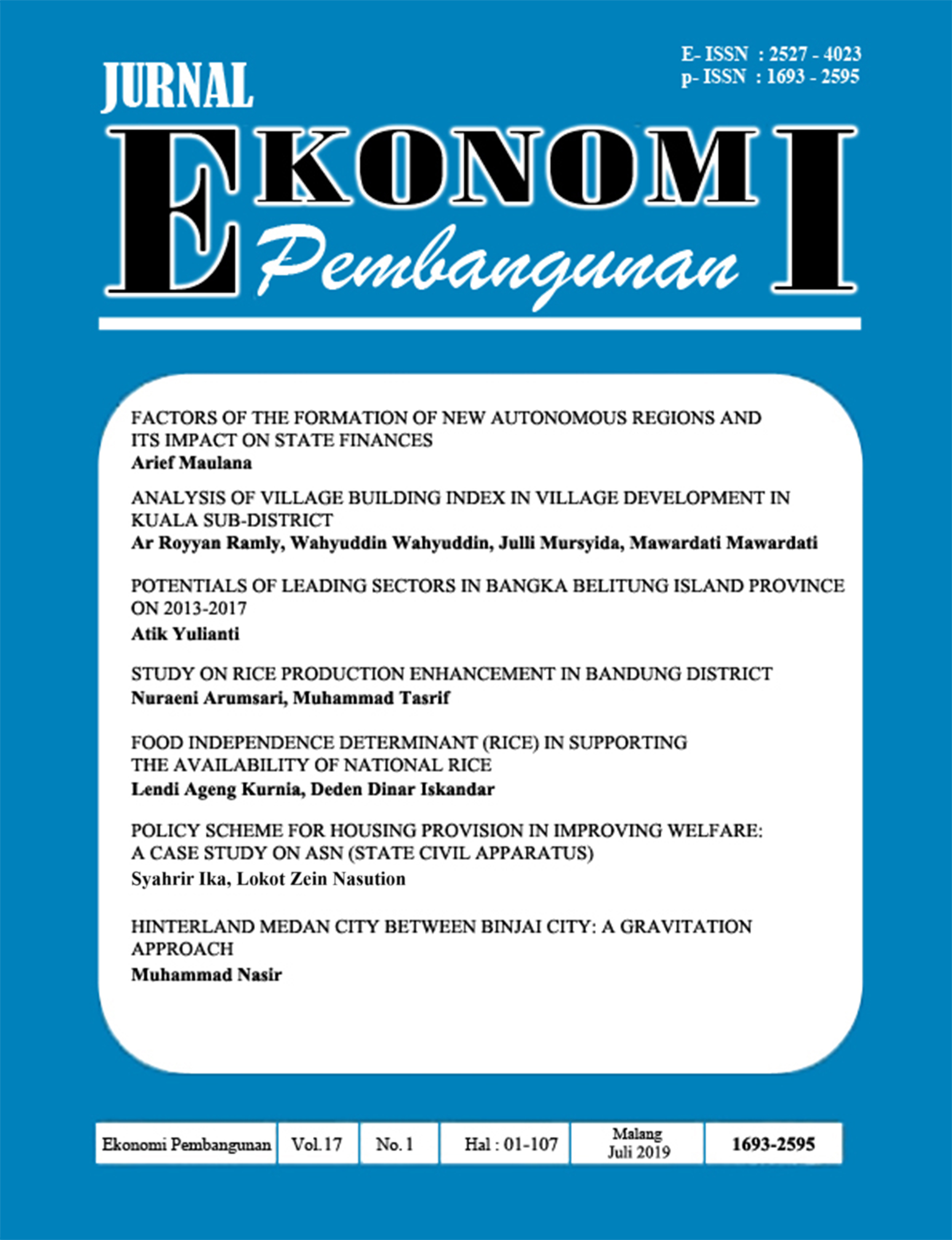Analysis Of Village Building Index In Village Development In Kuala Sub-District
DOI:
https://doi.org/10.22219/jep.v17i1.8087Keywords:
Environmental Sensitivity Index, Economic Conditions Index, Healthy Family Index and Village Building IndexAbstract
This study aims to analyze the village building index in the development of village in Kuala sub-district of Nagan Raya regency. This research is descriptive qualitative and quantitative. The object of this study is 17 villages in the region of Kuala sub-district, while the data used in this study is sourced from primary and secondary data derived from document review, observation, FGD, and interviews from 2015 to 2017. Data analysis technique using descriptive analysis in the form of tables and diagrams, while the quantitative analysis using multiple regression test with the dependent variable percentage of village fund accumulation 2015-2017, independent variables are Environmental Sensitivity Index, Economic Conditions Index, Healthy Family Index and Village Building Index. The results showed that the analysis of the use of village funds for development in Kuala sub-district positively influence. Then with the development of village infrastructure and empowerment, the status of villages in the region of Kuala sub-district increased with an average developing status of 71 percent and advanced village status of 23 percent.
Downloads
References
Abidin, M.Z (2015). Tinjauan Atas Pelaksanaan Keuangan Desa Dalam Mendukung Kebijakan Dana Desa (Study Of Implementation Of Village Finance To Support Fund Village Policy). Jurnal Ekonomi & Kebijakan Publik, Vol. 6 No. 1.
Adisasmita, R. (2006). Membangun Desa Partisipatif. Yogyakarta: Graha Ilmu.
Azwardi & Sukanto, (2014). Effectiveness of Village Fund Allocation (ADD) and Poverty in South Sumatera Province, Journal of Economic & Development 12(1), 29-41.
BPS. Statistik Daerah Kecamatan Kuala 2016. BPS Nagan Raya.
Daldjoeni dan Suyitno.(2004). Perdesaan, Lingkungan Dan Pembangunan. Bandung: PT Alumni.
Halim, A. (2004). Bunga Rampai Manajemen Keuangan Daerah. Edisi Revisi. Yogyakarta: UPP AMP YKPN.
Kementerian Desa, Pembangunan Daerah Tertinggal Dan Transmigrasi. (2015) Indek Desa Membangun 2015.
Miles, M.B. & Huberman, A.M. (1992). Analisis Data Kualitatif. Jakarta: UI Press.
Miles, M.B., Huberman, A.M. (1994), Qualitative Data Analysis. 2nded. Thousand Oaks, CA: Sage Publications.
Misbahul, A.dan Jatmiko, B. (2012). Kontribusi Dan Peran Pengelolaan Keuangan Desa Untuk Mewujudkan Anggaran Pendapatan Dan Belanja Desa Yang Transparansi Dan Akuntabel (Survey Pada Perangkat Desa Di Kecamatan Ngaglik, Sleman, Yogyakarta). Jurnal Universitas Muhammadiyah Yogyakarta.
Permen Dalam Negeri Nomor 51/2007.
Purwaningsih, E. (2008). Partisipasi Masyarakat Dalam Pembangunan Desa. Jurnal Jantra, 3(6), 443 452.
Rahmawati, H.I. (2015). Analisis Kesiapan Desa Dalam Implementasi Penerapan UU Nomor 6 Tahun 2014 Tentang Desa (Studi Pada Delapan Desa Di Kabupaten Sleman). The 2nd University Research Coloquium 2015 ISSN 2407-9189.
Ramly, A. dan Wahyuddin, (2017). Implementasi Kebijakan Dana Desa Dalam Pengelolaan Dan Peningkatan Potensi Desa (Studi Kasus Kec Kuala Kabupaten Nagan Raya), Seminar Nasional II USM 2017 Eksplorasi Kekayaan Maritim Aceh di Era Globalisasi dalam Mewujudkan Indonesia sebagai Poros Maritim Dunia Vol. 1, 379-392.
Ramly, A. dan Wahyuddin, (2018). The Model and Strategy Improved of Empowering Economic Community Based on Village Fund Allocation: Empirical Study in Kuala Sub district, Nagan Raya District), Advanced Science Letters Vol. 24, 362-364.
Riyanto dan Junaedi (2017). Implikasi Penggunaan Dana Desa Terhadap Ketahanan Sosial, Ekonomi, dan Ekologi Desa Tertinggal di Kabupaten Karanganyar. Jurnal Sainstech Politeknik Indonusa Surakarta ISSN : 2355 5009 Volume 4 Nomor 2 Desember 2017.
Setyobakti, H. M. (2017). Identifikasi masalah dan Potensi Desa Berbasis Indek Desa Membangun di Desa Gondowangi Kecamatan Wagir Kabupaten Malang. Jurnal Penelitian Ilmu Ekonomi WIGA, 7, 1–14.
Sofianto, A. (2017). Kontribusi Dana Desa terhadap Pembangunan dan Pemberdayaan Masyarakat di Kebumen dan Pekalongan. Matra Pembaruan Daerah (Bappeda) Provinsi Jawa Tengah. Jl. Pemuda No, 1(1), 23–32.
Sugiyono. (2006). Metode Penelitian Kuantitatif, Kualitatif dan R&D (Qualitative and Quantitative Research Methods). Bandung: Alfabeta.
Team KOMPAK (2017). Policy Analysis Village Fund and Poverty Allevation. Jakarta: Australian-Indonesian Government Patnership. Page (1-8).
UU No 6 Tahun 2014 tentang Desa (2014). Republik Indonesia.
Permendes No 2 Tahun 2016 Tentang Indeks Desa Membangun.
Oktaviana, O. dan Bachruddin, D.T, (2017), The Efforts to Improve Developing Village Index in Banten Province Region Through Policy Intervention of Provincial Government, Conference: Seminar Nasional Laboratorium Administrasi Publik 2017 “Pengembangan Kawasan Berbasis Pembangunan Berkelanjutan”.
Downloads
Published
Issue
Section
License
Authors who publish with Jurnal Ekonomi Pembangunan (JEP) agree to the following terms:
- For all articles published in Jurnal Ekonomi Pembangunan (JEP), copyright is retained by the authors. Authors permit the publisher to announce the work with conditions. When the manuscript is accepted for publication, the authors agree to the publishing right's automatic transfer to the publisher.
- Authors retain copyright and grant the journal right of first publication with the work simultaneously licensed under a Creative Commons Attribution-NonCommercial-ShareAlike 4.0 International License that allows others to share the work with an acknowledgment of the work's authorship and initial publication in this journal.
- Authors can enter into separate, additional contractual arrangements for the non-exclusive distribution of the journal's published version of the work (e.g., post it to an institutional repository or publish it in a book), with an acknowledgment of its initial publication in this journal.
- Authors are permitted and encouraged to post their work online (e.g., in institutional repositories or on their website) before and during the submission process, as it can lead to productive exchanges and earlier and greater citation of published work (See The Effect of Open Access).

This work is licensed under a Creative Commons Attribution-NonCommercial-ShareAlike 4.0 International License.






















